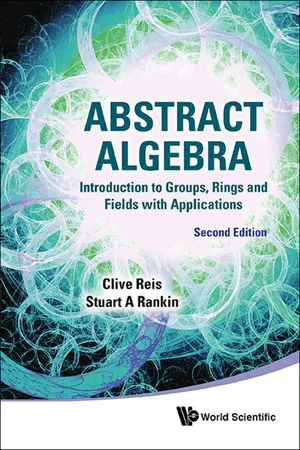
Abstract Algebra
Introduction to Groups, Rings and Fields with Applications
- 576 pages
- English
- ePUB (mobile friendly)
- Available on iOS & Android
Abstract Algebra
Introduction to Groups, Rings and Fields with Applications
About this book
This second edition covers essentially the same topics as the first. However, the presentation of the material has been extensively revised and improved. In addition, there are two new chapters, one dealing with the fundamental theorem of finitely generated abelian groups and the other a brief introduction to semigroup theory and automata.
This book is appropriate for second to fourth year undergraduates. In addition to the material traditionally taught at this level, the book contains several applications: Polya–Burnside Enumeration, Mutually Orthogonal Latin Squares, Error-Correcting Codes, and a classification of the finite groups of isometries of the plane and the finite rotation groups in Euclidean 3-space, semigroups and automata. It is hoped that these applications will help the reader achieve a better grasp of the rather abstract ideas presented and convince him/her that pure mathematics, in addition to having an austere beauty of its own, can be applied to solving practical problems.
Considerable emphasis is placed on the algebraic system consisting of the congruence classes mod n under the usual operations of addition and multiplication. The reader is thus introduced — via congruence classes — to the idea of cosets and factor groups. This enables the transition to cosets and factor objects to be relatively painless.
In this book, cosets, factor objects and homomorphisms are introduced early on so that the reader has at his/her disposal the tools required to give elegant proofs of the fundamental theorems. Moreover, homomorphisms play such a prominent role in algebra that they are used in this text wherever possible.
Request Inspection Copy
Frequently asked questions
- Essential is ideal for learners and professionals who enjoy exploring a wide range of subjects. Access the Essential Library with 800,000+ trusted titles and best-sellers across business, personal growth, and the humanities. Includes unlimited reading time and Standard Read Aloud voice.
- Complete: Perfect for advanced learners and researchers needing full, unrestricted access. Unlock 1.4M+ books across hundreds of subjects, including academic and specialized titles. The Complete Plan also includes advanced features like Premium Read Aloud and Research Assistant.
Please note we cannot support devices running on iOS 13 and Android 7 or earlier. Learn more about using the app.
Information
Chapter 1
Logic and Proofs
1.1 Introduction
1.2 Statements, Connectives and Truth Tables
The Connective ¬ (negation).
Table of contents
- Cover page
- Title page
- Copyright
- Contents
- Preface to the Second Edition
- Preface to the First Edition
- List of Figures
- List of Tables
- 1. Logic and Proofs
- 2. Set Theory
- 3. Cartesian Products, Relations, Maps and Binary Operations
- 4. The Integers
- 5. Groups
- 6. Further Properties of Groups
- 7. The Symmetric Groups
- 8. Rings, Integral Domains and Fields
- 9. Polynomial Rings
- 10. Field Extensions
- 11. Latin Squares and Magic Squares
- 12. Group Actions, the Class Equation, and the Sylow Theorems
- 13. Finitely Generated Abelian Groups
- 14. Semigroups and Automata
- 15. Isometries
- 16. Pólya-Burnside Enumeration
- 17. Group Codes
- 18. Polynomial Codes
- Appendix A Rational, Real, and Complex Numbers
- Appendix B Linear Algebra
- Index